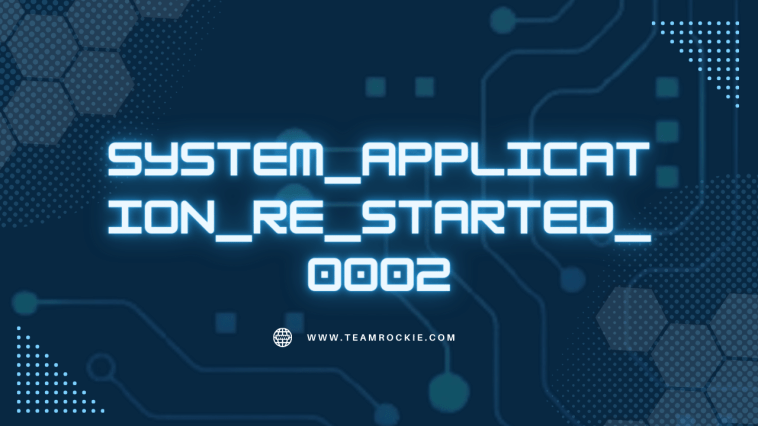In the ever-evolving world of technology, the stability and efficiency of IT systems are paramount. A particular aspect that often goes unnoticed but plays a crucial role in maintaining this stability is the system restart process, specifically the System_Application_Re_Started_0002 protocol. This article delves into the significance of this process, its impact on IT infrastructure, and best practices for maximizing system uptime and performance.
Understanding System_Application_Re_Started_0002

Why Does System_Application_Re_Started_0002 Happen?
At the core of the System_Application_Re_Started_0002 alert lies an unexpected system application restart. This can be due to various factors, including faulty hardware, software bugs, resource constraints, and power fluctuations. Essentially, this restart acts as a self-healing mechanism, aiming to restore system stability without manual intervention. Though it might seem abrupt, this process is a testament to a system’s resilience and its ability to self-correct.
Troubleshooting and Management Strategies
When encountering a System_Application_Re_Started_0002 alert, it’s crucial to approach the issue methodically. This involves documenting the context of the crash, updating drivers and software, checking system logs, stress testing hardware, and resetting application configurations. Such detailed troubleshooting helps in pinpointing the root cause and ensuring the smooth functioning of the system.
Preventing Future System_Application_Re_Started_0002 Alerts

To avert future occurrences of this error, several proactive steps are recommended:
- Regular Updates: Keeping all system components up-to-date is critical in minimizing the risk of crashes and errors.
- System Clean-ups: Regular maintenance, such as cleaning temporary files and caches, plays a significant role in preventing resource-related errors.
- Continuous Backups: Regular backups ensure that the system can be quickly restored to a stable state in case of persistent issues.
- System Monitoring: Keeping an eye on key metrics helps in early detection of potential problems.
- Hardware Upgrades: Timely hardware refreshes can significantly reduce the chances of crashes due to component failure.
Maximizing System Uptime with Controlled Restarts

Automating the System_Application_Re_Started_0002 Process
Automation in managing the System_Application_Re_Started_0002 process can drastically enhance efficiency and reduce manual workload. This includes setting up automated notifications for technical teams, tuning restart thresholds, and implementing user experience strategies during downtime. These measures ensure that the system remains resilient, with minimal disruption to users.
Best Practices for Large Systems
In large IT environments, managing application restarts is more complex. It involves standardizing configurations across devices, enhancing logging for in-depth analysis, and scheduling maintenance strategically. These practices not only streamline the restart process but also contribute to the overall health of the IT infrastructure.
The Role of Controlled Restarts in System Health
Controlled restarts, such as those in the System_Application_Re_Started_0002 protocol, are crucial for maintaining digital service reliability. They allow systems to recover quickly from errors and maintain high uptime. In large-scale environments, like server clusters, these restarts help in balancing loads and ensuring seamless service delivery.
Impact of System_Application_Re_Started_0002 on IT Infrastructure

The implementation of the System_Application_Re_Started_0002 protocol has a profound impact on the broader IT infrastructure. It enhances network performance, ensures data integrity, and reduces downtime. This protocol is not just a troubleshooting step but a vital component in the overall IT strategy for performance optimization and reliability.
Comparing System_Application_Re_Started_0002 with Other Restart Protocols
It’s vital to understand how the System_Application_Re_Started_0002 stacks up against other restart protocols. This comparison sheds light on its efficiency, reliability, and resource management, demonstrating its superiority in various IT scenarios.
How to Implement System_Application_Re_Started_0002 Protocol?

Implementing the System_Application_Re_Started_0002 protocol is a critical step in ensuring the stability and reliability of IT systems. While the process may seem complex, following a well-defined set of guidelines can simplify its integration into your IT infrastructure. Here’s a step-by-step guide to implementing this protocol effectively:
- Assessment of Current System Status: Before implementing any protocol, it’s essential to evaluate the current state of your IT system. Identify areas that require improvement and assess the potential benefits of integrating the System_Application_Re_Started_0002 protocol.
- Documentation and Planning: Begin by documenting the existing system architecture, including hardware, software, and network configurations. Create a detailed plan that outlines the implementation process, objectives, and expected outcomes.
- Software and Hardware Compatibility: Ensure that your existing software and hardware are compatible with the protocol. If necessary, upgrade or replace components to meet the protocol’s requirements.
- Selection of the Right Tools: Choose the appropriate tools and software solutions to facilitate the implementation of the protocol. Consider automation tools, monitoring systems, and diagnostic software to streamline the process.
- Training and Skill Development: Provide training and skill development opportunities for your IT team. Ensure that they are well-versed in the protocol’s procedures and troubleshooting techniques.
- Testing and Validation: Before deploying the protocol in a production environment, conduct rigorous testing and validation. Simulate various scenarios, including system failures, to ensure that the protocol responds effectively.
- Deployment and Monitoring: Once you are confident in the protocol’s performance, deploy it in your production environment. Continuously monitor its operation, gather data on its effectiveness, and make necessary adjustments.
- Documentation and Reporting: Maintain detailed documentation of the implementation process and ongoing performance. Regularly generate reports that highlight the impact of the protocol on system stability and performance.
- Iterative Improvement: IT environments are dynamic, and system requirements change over time. Continuously review and improve the protocol to adapt to evolving needs and technologies.
- Security Measures: Implement robust security measures to protect the protocol from potential threats or vulnerabilities. Regularly update security protocols and conduct security audits to ensure the safety of your system.
By following these steps and dedicating resources to the proper implementation of the System_Application_Re_Started_0002 protocol, you can enhance your IT infrastructure’s stability and resilience, ultimately leading to improved performance and user satisfaction.
Benefits of Regular Application Restarts in System Performance

Regular application restarts, including those governed by the System_Application_Re_Started_0002 protocol, offer a multitude of benefits for overall system performance. These scheduled restarts are not mere inconveniences but strategic actions aimed at optimizing system health. Let’s explore the advantages of incorporating regular application restarts into your IT strategy:
- Memory and Resource Optimization: Over time, applications can consume significant amounts of memory and resources. Regular restarts free up these valuable assets, preventing memory leaks and resource bottlenecks that can lead to system slowdowns.
- Enhanced Stability: Frequent application restarts help identify and address potential stability issues early. By proactively resolving software glitches and bugs, you minimize the risk of system crashes and downtime.
- Improved Response Time: Restarting applications clears cached data and resets internal processes, resulting in faster response times. This is particularly beneficial for applications that handle large datasets or complex calculations.
- Reduced Accumulated Errors: Long-running applications may accumulate errors or performance degradation over time. Restarting them periodically resets the application’s state, reducing the risk of errors and improving overall reliability.
- Resource Reclamation: Application restarts release system resources previously allocated to closed processes. This resource reclamation ensures efficient resource utilization across your IT infrastructure.
- Enhanced Security: Regular restarts help in applying security updates and patches effectively. By restarting applications after updates, you ensure that security vulnerabilities are addressed promptly.
- Predictable Maintenance: Scheduled restarts can be planned during off-peak hours, minimizing disruptions to users. This predictability allows for proactive maintenance without unexpected downtime.
- User Experience: Users benefit from improved application performance and reduced downtime, leading to a better overall user experience. Satisfied users are more productive and less likely to encounter frustration.
- System Health Insights: Monitoring the impact of regular restarts provides valuable insights into your system’s health and performance. It allows you to identify trends, address recurring issues, and fine-tune your IT strategy.
- Energy Efficiency: Restarting applications can also lead to energy savings by preventing applications from running continuously, especially on energy-intensive servers.
Incorporating regular application restarts, such as those enforced by the System_Application_Re_Started_0002 protocol, is a proactive approach to maintaining system performance, stability, and security. By reaping these benefits, organizations can ensure that their IT infrastructure operates at its full potential, meeting the demands of the digital age.
Troubleshooting Common Issues in System_Application_Re_Started_0002

While the System_Application_Re_Started_0002 protocol is designed to enhance system stability, occasional issues may still arise. Troubleshooting these common problems is crucial to maintaining a smoothly functioning IT environment. Here are some common issues you may encounter and their solutions:
- Frequent Restarts: If your system experiences frequent System_Application_Re_Started_0002 alerts, it may indicate underlying issues. Investigate hardware problems, software conflicts, or resource constraints that trigger these frequent restarts. Address the root causes to reduce the frequency of alerts.
- Incomplete Restarts: Sometimes, an application restart initiated by the protocol may not complete successfully, leaving the system in a partially restarted state. Review application configurations, dependencies, and resource availability to ensure a seamless restart process.
- Performance Degradation After Restart: If you notice a drop in performance immediately after a restart, it could be due to resource contention or inefficient application initialization. Monitor resource utilization during startup and optimize configurations as needed.
- Inconsistent Alerts: Inconsistencies in System_Application_Re_Started_0002 alerts may result from misconfigured monitoring systems or issues with the alerting mechanism itself. Regularly review and test your alerting infrastructure to ensure its accuracy and reliability.
- Unresolved Application Errors: If the protocol repeatedly restarts a specific application due to errors, investigate the root cause of these errors. It could be a software bug or compatibility issue that requires a targeted fix.
- Resource Exhaustion: Ensure that the system has adequate resources, including memory, CPU, and storage, to support the System_Application_Re_Started_0002 protocol. Resource exhaustion can lead to failed restart attempts or system instability.
- Lack of Documentation: Inadequate documentation of the protocol’s implementation and operation can hinder troubleshooting efforts. Maintain detailed records of protocol configurations, alert history, and system changes to aid in problem resolution.
- Security Concerns: Assess the security of the protocol to prevent potential vulnerabilities that could be exploited. Regularly update and patch any components related to the protocol to maintain its integrity.
- Over-Reliance on the Protocol: While the protocol is a valuable tool, it should not be used as a band-aid solution for deeper system issues. Address underlying problems, such as software bugs or hardware failures, to minimize the need for frequent restarts.
- Performance Monitoring: Implement comprehensive performance monitoring tools to identify and diagnose issues before they trigger System_Application_Re_Started_0002 alerts. Proactive monitoring can help prevent common problems.
By addressing these common issues and implementing best practices for troubleshooting, you can ensure that the System_Application_Re_Started_0002 protocol operates effectively and contributes to a stable IT environment. Troubleshooting should be a continuous process aimed at enhancing system performance and reliability.
Comparing System_Application_Re_Started_0002 with Other Restart Protocols
The world of IT is replete with various restart protocols and mechanisms, each designed to address specific needs and challenges. Comparing the System_Application_Re_Started_0002 protocol with other restart protocols provides valuable insights into its efficiency, reliability, and impact on system resources. Let’s explore how it stacks up against some common restart methods:
Hard Reboots vs. System_Application_Re_Started_0002:
System_Application_Re_Started_0002 is a more controlled and targeted restart process compared to hard reboots. While hard reboots reset the entire system, potentially causing data loss and longer downtime, System_Application_Re_Started_0002 focuses on restarting specific applications, minimizing disruption.
Manual Restarts vs. System_Application_Re_Started_0002:
Manual restarts rely on human intervention and are subject to delays. In contrast, System_Application_Re_Started_0002 automates the restart process, reducing response time and ensuring a consistent approach to application recovery.
Failover Clusters vs. System_Application_Re_Started_0002:
Failover clusters are designed to provide continuous service by switching to redundant systems in case of failure. System_Application_Re_Started_0002 complements failover clusters by automatically restarting applications on the same system, improving availability without the need for failover.
Scheduled Restarts vs. System_Application_Re_Started_0002:
Scheduled restarts are typically performed during maintenance windows, resulting in planned downtime. System_Application_Re_Started_0002 initiates restarts in response to specific application errors or issues, reducing the need for scheduled downtime.
Graceful Restarts vs. System_Application_Re_Started_0002:
Graceful restarts involve stopping and restarting an application in a controlled manner. System_Application_Re_Started_0002 focuses on rapid recovery, often without the need for graceful shutdowns, making it suitable for addressing unexpected errors.
Resource Utilization:
System_Application_Re_Started_0002 is resource-efficient as it targets specific applications, conserving system resources. Other restart methods, such as hard reboots or complete system restarts, may consume more resources and time.
Impact on Data:
Unlike some restart methods that can lead to data loss or corruption, System_Application_Re_Started_0002 minimizes the risk to data integrity as it primarily deals with application-level restarts.
Scalability:
System_Application_Re_Started_0002 can be seamlessly integrated into both small-scale and large-scale IT environments, providing flexibility and scalability.
FAQs
What causes a System_Application_Re_Started_0002 error?
This error is typically triggered by issues such as faulty hardware, software bugs, resource limitations, or power inconsistencies.
How can System_Application_Re_Started_0002 errors be prevented?
Regular updates, system clean-ups, continuous backups, monitoring, and timely hardware upgrades are effective in preventing these errors.
Is System_Application_Re_Started_0002 a sign of a serious problem?
While it indicates a self-healing action, frequent occurrences should be investigated as they may signal deeper issues.
How does automation improve the restart process?
Automation reduces manual intervention, ensures timely responses, and minimizes disruption to users during restarts.
What role does System_Application_Re_Started_0002 play in IT infrastructure?
It enhances network performance, ensures data integrity, and reduces downtime, making it a crucial component of IT infrastructure management.
Also Read: Unveiling the Huawei MatePad Pro 13.2: A Fusion of Elegance and Efficiency
Final Words
In conclusion, the System_Application_Re_Started_0002 protocol is a powerful tool in the arsenal of IT professionals, enabling them to maintain system health, optimize performance, and ensure uninterrupted service delivery. By understanding its significance and implementing best practices, organizations can pave the way for a more stable and reliable IT environment.




